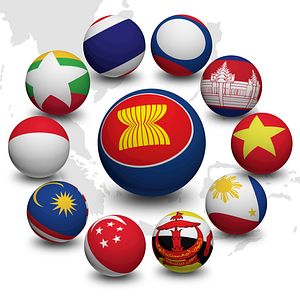Southeast Asia is a pivotal region for Canada, and its recently launched Indo-Pacific Strategy places a strong emphasis on strengthening the relationship with this dynamic area. An impressive funding of 2.3 billion Canadian dollars has been earmarked for this strategy over the next five years, with over 10 percent specifically allocated for the Association of Southeast Asian Nations (ASEAN). One of the primary objectives is to bolster the trade relationship with this strategic region in the Indo-Pacific.
In November 2021, exactly one year prior to the strategy’s announcement, ASEAN and Canada initiated negotiations for the ASEAN-Canada Free Trade Agreement (FTA). This remarkable development in the partnership between ASEAN and Canada signifies Ottawa’s unwavering commitment to promoting trade and economic engagement in the region – an essential strategy to diversify Canada’s trade and investment, which has traditionally focused on the United States and China.
The 2018 Joint Feasibility Study conducted by ASEAN and Canada for the ASEAN-Canada FTA underscored the potential of implementing an agreement that encompasses the liberalization of goods, reduction of non-tariff measures, and enhancements in trade facilitation. The study revealed that such an agreement would yield substantial economic benefits, including a remarkable boost of US$39.4 billion (1.6 percent) to ASEAN’s GDP and US$5.1 billion (0.3 percent) to Canada’s GDP. Moreover, the agreement would fuel ASEAN’s exports to Canada by a staggering US$3.36 billion (18.7 percent) and Canadian exports to ASEAN by an impressive US$3.18 billion (26.5 percent).
In addition to economic gains, the ASEAN-Canada FTA would grant Canada market access to ASEAN countries that are not part of the Comprehensive and Progressive Agreement for Trans-Pacific Partnership (CPTPP): Cambodia, Indonesia, Laos, Myanmar, the Philippines, and Thailand. This presents a wealth of opportunities for Canada across diverse export-oriented industries such as oil and gas, mining, advanced technology, telecommunications, agri-food, financial services, aviation, and consumer goods. Each of these nations offers significant prospects for Canadian businesses to thrive and expand their reach.
Furthermore, implementing the ASEAN-Canada FTA would level the competitive landscape for Canada in the region, particularly in comparison to Australia and New Zealand. These two countries, already beneficiaries of a regional FTA, currently enjoy preferential entry for their exporters into ASEAN member nations. By joining them through its own FTA with ASEAN, Canada would ensure fair competition and create a level playing field, allowing Canadian exporters to tap into the immense potential of the Southeast Asian market for crucial agricultural and natural resource commodities.
Negotiating a free trade agreement with ASEAN, however, is an arduous task, fraught with challenges at every level. The intricacies of the “three-level game” complicate the process as ASEAN engages in negotiations with countries like Canada.
At the national level, each ASEAN member state steers the negotiation ship according to its domestic interests. Diverse agendas and priorities compete to influence the national government, making consensus-building a formidable task.
Moving up to the regional level, ASEAN must strive for unity among its member states. But achieving consensus within this diverse bloc is no walk in the park. It is a long, drawn-out battle, requiring diplomatic finesse and countless rounds of discussions.
Now comes the international level, where Canada enters the picture. As negotiations progress between ASEAN and Canada, they navigate through a maze of complexities. It is a high-stakes game, where both parties must find common ground amidst their divergent interests.
However, the challenges do not end there. Within ASEAN itself, a “two-tier” dynamic adds another layer of complexity. The advanced economies of the ASEAN-6 (Brunei, Indonesia, Malaysia, the Philippines, Singapore, and Thailand) contrast sharply with the emerging economies of Cambodia, Laos, Myanmar, and Vietnam (CLMV). Income disparities, differing levels of human resources, institutional capacity, infrastructure development, and overall competitiveness create a rift that must be bridged for a successful FTA.
Canada, eager to secure a favorable deal, is pushing for the inclusion of six critical areas in the negotiation discussions. These areas cover labor, environment, gender, monopolies and state-owned enterprises, government procurement, and transparency and anti-corruption. But given the varying levels of development within ASEAN, finding common ground on these topics is an uphill battle.
In the quest for a mutually beneficial FTA, ASEAN and Canada are faced with the challenging task of finding common ground. However, a staggered approach may hold the key to swiftly concluding the FTA negotiations. By focusing on major areas such as trade in goods, services trade, investment, e-commerce, intellectual property, competition policy, and dispute settlement mechanisms, both sides could finalize initial agreements. This approach allows for a gradual inclusion of more advanced areas in the agreement as both parties agree to negotiate the upgrading of the ASEAN-Canada FTA in the future.
Taking inspiration from successful models, such as the ASEAN-Australia-New Zealand FTA, which was recently upgraded to encompass new chapters and provisions, ASEAN and Canada can follow a similar path. This approach allows for flexibility and adaptation over time. Canada has also shown openness to upgrading FTAs, as demonstrated by the Canada-Chile FTA, which was enhanced in 2019 to include a chapter on trade and gender. Therefore, a staggered approach is both feasible and potentially acceptable to both ASEAN and Canada.
Addressing the development gap within ASEAN is another crucial aspect that needs attention. Bridging this gap is essential to ensure that ASEAN member states are ready to include more advanced areas in the FTA. To achieve this, Canada should consider supporting capacity building initiatives for its ASEAN partners, particularly in the six areas it advocates: labor, environment, gender, monopolies and state-owned enterprises, government procurement, and transparency and anti-corruption.
By finding a middle-ground approach and prioritizing key areas of agreement, ASEAN and Canada can pave the way for a successful FTA that brings mutual benefits and strengthens economic ties. The willingness of both parties to adapt and upgrade the agreement over time demonstrates their commitment to fostering a robust and inclusive trade relationship. As negotiations continue, addressing the development gap and supporting capacity building efforts will be crucial for achieving a comprehensive and balanced ASEAN-Canada FTA.

































